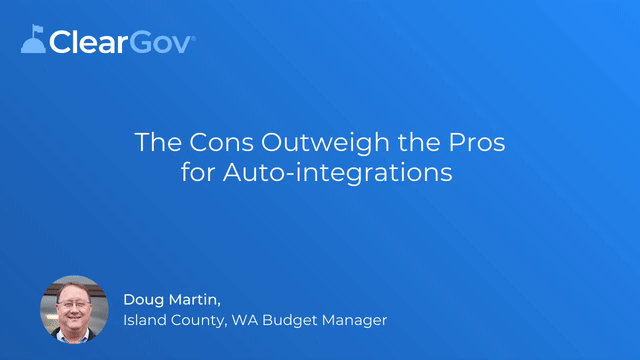Should Your Budgeting Software Integrate With Your Accounting Software? Doug Martin, Budget Manager of Island County, WA Weighs in…For some, auto-integration in a budgeting system is a must-have. But is an auto-integrated system more hassle than it’s worth? A few negative side effects of auto-integrated systems include accounting systems breaking, inadvertently providing malicious parties with access to sensitive data, spending excess money and time on IT support resources, and spending extra monthly money on integrations even outside of budget season. So, is auto-integration a must-have for local government finance departments, or is it a hindrance and a headache? We asked Doug Martin, Budget Manager of Island County, WA (and ClearGov customer) to weigh in based on his years of experience in local government finance. Q: Why were you adamant about not moving forward with a budget provider that did auto-integration to your accounting system?A: The primary reason for us is that I know what our accounting system can do, and I know what it can’t do. There are weaknesses that I did not want to expose to the light of day. I didn’t want to take a chance with integrating a new product just to have it shut my accounting system down, nor do I have the opportunity to replace my accounting system with an all-inclusive package that does everything so integration isn’t necessary. That’s a very expensive proposition. Q: Have you been through auto-integrations before, and can you tell us a little bit about your experience with that?A: The auto-integrations I’ve had before have been bought with a lot of money, and therefore, they worked for the most part. I think what I’m trying to say is that you can buy a product that will auto-integrate, but you’ve got to make sure there’s enough resources behind that product to be able to have the auto-integration work. And, you’ve got to make sure the two products talk to each other. I can actually think of two other entities (that I didn’t work for) that had Product A. They wanted to bring in Product B to do their budgeting, and the vendor said it wouldn’t be a problem. But then, when they did the deal, they auto-integrated, and the vendor said it wouldn’t work with that particular version. You’ve got to have all of those details worked out. Q: You talked a little bit about the resources you need, which isn’t just money. What type of time or IT support on your end would a community expect to invest?A: If you’re going to auto-integrate, you’re going to have to build up your IT support team in a material way. It’s not going to be just programmers, it’s going to be the integration and hardware specialists who come in to make sure that everything works. You can’t just rely on a consultant that you hire who comes in and says, “Oh, yeah, I know how your product works, and I’ll whip up the flow to get us dialed into your system.” If something doesn’t work after the consultant leaves, you’ve got to find that consultant again – or you’re going to have to have someone on staff, which takes additional funding. You have to build out your team to make sure that the system works. Q: Without getting into specifics, in terms of timelines, what could you expect if you were going with the all-encompassing, fully-integrated suite? How long should someone expect about how long they’re told it will take versus how long it will actually take?A: I can tell you that, in my experience, when we went from a vendor product to a home-built product, that worked really well, but it took us two years to get it up and running. And there are so many nuances you have to deal with. You’re running your old system, you build the new one, you run them concurrently to make sure they’re doing the same thing, and then you have your transfer over, but something never works all the time, so then you have to make sure it runs. You have to maintain your old system in the background to make sure you go through a whole financial cycle with the new system to make sure that all the processes work, because some things you do, you only do once a year. So it’s a two-year process to go from System A to System B on a fully-integrated process. If you’re talking about keeping your existing accounting system and bringing in someone to integrate a second product, you’re looking at 6 months. Because again, you’ve got to be able to build that path, drill the hole, make sure it’s all working, test it, make sure you’re not letting any bugs in, and then do the same process where you test the integration to make sure it touches all the aspects of the process.
Q: For the system that took two years, what were the up-front expectations?A: We were told it would take 6 months to get it up and running and a full year to work out the kinks…And it took 2 years. Q: One thing that commonly comes up when people are thinking about an auto-integration is that they’re thinking one of the benefits would be, “Hey, the entire year I have an auto-integration, so I can see what the actuals are looking like as I’m going through the year.” The problem is that when it plays out, they typically run into one of two things: either it’s breaking or they didn’t actually work on the budget all year. Could you maybe speak to that a little bit?A: That’s actually a really good point. We do a budget once a year, and budgeting is a separate and distinct process where we take a snapshot of our accounting data in June to use as our basis, and then we use that to build our budget. Sometimes we update our accounting data on those material changes but it mostly stays the same. Then, once we develop the budget, we load it into the accounting system. We don’t need the integration. Unless someone has a really complex or large entity, they don’t need auto-integration. I don’t need my budget tool to integrate with my accounting tool on a daily basis, or weekly, or even monthly. We don’t need it because we don’t change our budget very often. Q: Is there anything else that you would leave people looking to change budgeting system providers with a word of advice on?A: I cannot overemphasize enough the importance of the user-friendliness of a product, and you won’t know the difference until you actually go out and compare different products. It wasn’t my favorite use of my time, but it’s the only way to know. Implementation timeliness is also important. It was important for me to get my product up and running quicker than others. I didn’t want to spend 6 months working on a product that I can’t use for a year. And as I went through my journey of talking to different vendors, I found those that were able to speak to their product with confidence and with a positive approach were the ones that filtered to the top.
|







